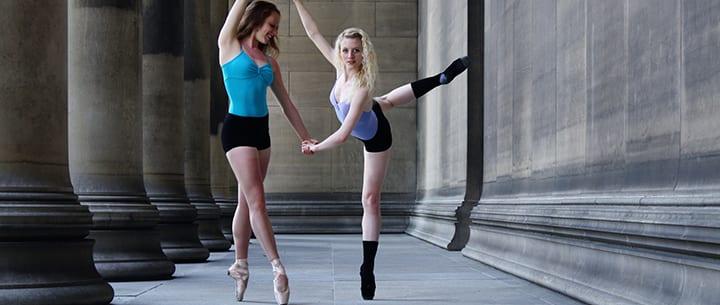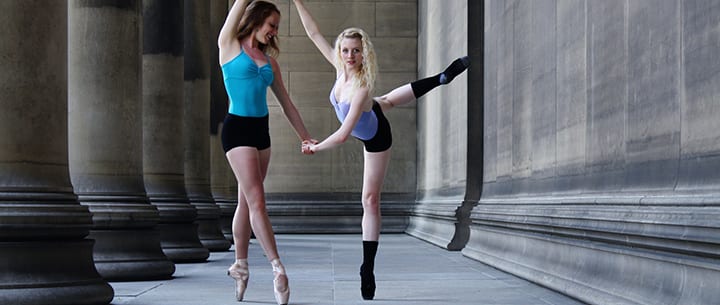Do you dream of being a professional dancer someday? Beyond just dance skills, you’ll need to know how to write a dance resume to start on your career path. Read on for some great advice from New York dancer and teacher Caitlin J.:
For the pre-professional dancer, landing your first paid gig can be a daunting task. With only a few contacts, it is difficult to know where to start. Most jobs require a minimum submission of a headshot and resume.
While you might feel like your resume is sparse, a little reflection on your dance education and involvement may prove that you are more experienced than you think.
A resume is a document that outlines your qualifications, skills, and experience. It is one of the most important tools in your job search arsenal and should be tailored to each individual job you apply for. As a dancer, your resume should highlight your training, performances, and any other relevant experience.
If you’ve never written a resume before, the process can seem daunting. But don’t worry—we’re here to help! In this blog post, we’ll provide some tips on how to write your first professional dance resume.
What Should I Put on My Resume for Music?
Your resume should reflect your musical experience and abilities, as well as your professional achievements. Here are some tips on what to include on your resume:
- List your musical training, including any degrees or certifications you have earned.
- Showcase your performance experience by listing the ensembles you have played with, as well as any solo performances or recitals you have given.
- If you have any experience teaching music, be sure to list the students you have taught, as well as the techniques or methods you used.
- List any special skills or experience that might be relevant to the job you’re applying for, such as experience working with audio equipment or composing music.
- Finally, don’t forget to list your contact information so that potential employers can reach you!
Still not totally sure what you should put on your dance resume? Be sure to ask your dance instructor for tips – and if you haven’t signed up for dance lessons yet, now is a great time to do so. A great dance teacher can help with more than just the technical work – they’ll give you dance resume examples to look at and more, like what you see in the video below:
https://www.youtube.com/watch?v=RMtpWe4u18I
Common Questions When Making a Dancer Resume
As a dancer, you know that first impressions are everything. The same can be said of your resume. Your resume is often the first point of contact between you and a potential employer, so it’s important to make sure that it’s polished and professional. Not sure where to start? Here are answers to some common questions about creating a standout dancer resume.
How Should I Format My Resume?
When it comes to resumes, there is no one-size-fits-all solution. However, there are some general guidelines that you should follow.
First, your resume should be easy to read and free of typos or grammatical errors. Second, it should be concise and to the point; two pages is typically sufficient for most dancer resumes.
Finally, it should be tailored specifically for the job that you’re applying for; generic resumes are unlikely to make a good impression on potential employers.
What Skills Do You Need to Be a Dancer?
There are many different types of dancing, from ballroom to ballet, hip-hop to contemporary. But all dancers have one thing in common: they have worked hard to perfect their craft. If you’re thinking about becoming a dancer, there are some skills you will need to develop in order to be successful.
Dancing is a physical activity, and like any physical activity, it requires strength and endurance. Dancers need to be able to execute powerful moves and maintain them for long periods of time. They also need the stamina to dance for extended periods of time, sometimes up to several hours at a time. To build the strength and endurance you need to be a successful dancer, you will need to engage in regular physical activity and stretching.
Flexibility is another important skill for dancers. Because they often contort their bodies into unnatural positions, dancers need to be able to stretch their muscles beyond what most people consider normal range of motion. This allows them the freedom of movement necessary to execute dance steps correctly and prevents injury. Again, regular stretching will help you develop the flexibility you need as a dancer.
Dancers must have excellent coordination in order to execute complicated dance steps correctly. This includes the coordination of arms, legs, and feet as well as the coordination of multiple body parts working together simultaneously. If you want to develop better coordination, try taking a dance class or participating in other activities that require coordination, such as martial arts or gymnastics.
Rhythm is an important skill for all dancers, regardless of the type of dancing they do. Dance is, after all, a form of communication through movement; thus, dancers must have a good sense of timing and rhythm in order to convey the message they’re trying to communicate through their dance movements. One way to develop your sense of rhythm is by listening to music and moving your body along with the beat.
How Do You List Performances on a Resume?
So how do you go about listing your performances on a resume? The first thing to keep in mind is that less is more. You don’t need to list every single performance you’ve ever been involved in; instead, focus on those that are most relevant to the role you’re applying for. For example, if you’re auditioning for a play, you might list the plays you’ve performed in that are similar in style or tone.
Once you’ve selected the performances you want to highlight, the next step is to list them in reverse chronological order. Start with your most recent performance and work your way back.
Finally, be sure to include the name of the play, your role, and the theater where it was performed.
By following these simple guidelines, you can be sure that your resume will make a strong impression on prospective employers.
What Should Be on a Dance Resume?
Dancers are artists who use their bodies to express themselves and tell a story. While many people think of dance as a hobby, it is actually a very competitive field. To be a professional dancer, you need to have training, experience, and a strong work ethic. You also need to be able to market yourself in order to get jobs. A dance resume is one way to do this.
1. Start With “Training”
This is a good place for dancers who desire to go professional to start because it will likely make up the bulk of your resume. The “Training” section is where you will list all the places you have taken dance lessons, the styles you have studied, and the instructors you were exposed to. It is good to get specific with your technique styles, for example “Precision Jazz” instead of just “Jazz”, or “Cecchetti Method” instead of just “Ballet”. And don’t worry if some of your instructors may not have had a notable professional career. If they could give a good personal reference on your behalf, they are worth mentioning by name on your resume.
2. Include any “Teaching Experience”
Here you will list places you have instructed, what style you were leading, and for how long. Maybe you haven’t had any professional teaching experience up to that point, but include times that you assisted a faculty instructor or choreographer. Whether you volunteered weekly at your home studio or demonstrated for a master teacher at a convention, this experience can be included on your first dance resume.
3. List Your “Stage/Live Performance” Background
This section of your resume is where you will list the most prominent performances you have been a part of. Make sure to list the name of the performance (ABC Ballet Academy Presents “Swan Lake”), your role in the production (“Odette”), and the months that the performance ran (Dec. 2013). If you can list several performances with the same studio or company, list first the company (“ABC Ballet Academy”), and then indented underneath all of the performance titles (“Swan Lake”, “Dracula”) each on their own separate line. Choose carefully which performances to include. If you have danced with the same ballet troupe since you were three, your principal roles are more important to note than your role as a flower in the garden from your days as a tiny tutu dancer.
4. Conclude With “Education”, “Skills”, and “Commercials/Industrials”
These three headers might not be included on every resume, and that is okay. “Education” is where you will list any secondary education you received from an accredited institution. If you only have a high school education, that may be listed here, but if you have received a college degree, do not list your high school education. “Skills” is where you will mention if you can tumble and what tricks you have mastered, if you are a vocalist and what your range is, if you play an instrument, or other skills. “Commercials/Industrials” are very rare for the beginner dancer, but may apply in some cases. If you were asked to dance on behalf of a company or brand, include that here. First list the event (“ABC Clothing Co. Fashion Show”), followed by the name of your contact/reference from the event as well as the date.
5. Remember These Final Tips
Be specific when listing your experiences (who you took from, where you studied, what style, and when you performed).
Be creative in areas where you think your experiences are lacking, don’t sell yourself short! Expand on what little experience you DO have.
Be selective in areas where you may have a lot of experience by not including the least recent or least relevant experiences.
Dance Resume Example
Any potential employer will want to see a resume when you apply for a job, and your dance resume is no exception.
Your dance resume should include your training, experience, and any special skills that you have. It should also list your contact information and any professional references you may have. If you have a particularly impressive dance resume, it can help you to stand out from the crowd and increase your chances of getting the job.
However, even if your dance resume is not as impressive as you would like, it is still important to include it with your application. A well-crafted resume can show potential employers that you are a serious candidate who is committed to getting the job.
Dance Teacher Resume Examples
When it comes to putting together a dance teacher resume, there are a few key things to keep in mind.
First of all, you’ll need to make sure that your resume is clear and concise. Dance teaching is a highly competitive field, so you’ll want to make sure that your resume stands out from the rest.
In addition, you’ll want to highlight your experience and skills in the dance world. If you have experience teaching different styles of dance, be sure to list that on your resume. You should also list any experience you have working with kids or adults. Finally, be sure to list any relevant certifications or training you have in the field of dance.
Dance Audition Resume
At first glance, a dance audition resume may not seem all that different from a traditional resume. However, there are a few key elements that should be included in order to make the most of this important document.
First and foremost, it is important to list any and all relevant training and experience. This should include both formal instruction and any performance experience, whether it be through school plays or professional gigs. In addition, it is also a good idea to list any special skills or notable accomplishments. For example, if you have won any competitions or have been awarded scholarships, be sure to mention this on your resume.
Finally, don’t forget to include contact information so that potential employers can reach you. By taking the time to create a well-rounded resume, you’ll be sure to stand out from the competition at your next dance audition.
General Dance Resume Template
Still confused?
Here are some templates you can look at as you are creating your dance resume.
Dance Instructor Resume – a Final Tip
Writing a professional dance resume may seem daunting at first, but following these tips will help you get started! Remember to tailor each resume to the specific job you’re applying for and highlight your training, performance experiences, related experiences, and anything else that makes you unique.
With a little effort and attention to detail, you’ll be sure to create a strong resume that will help you land gigs and advance your career! Make sure you ask your dance teacher for recommendations and advice when you’re working on your dance resume, too.
Now that you know how to write a dance resume, you’re on the right track to finding the career of your dreams. Happy job hunting!
Caitlin J. is a Manhattan-based professional dancer and fitness instructor. She is currently performing as a Brooklynettes dancer for the 2014-2015 NBA season. Some highlights of her education include attending the Radio City Rockette Summer Intensive, a contemporary dance apprenticeship at Dance Alloy, and David DeMarie Dance Studio summer sessions alongside stars from SYTYCD. Learn more about Caitlin here!
(Photo by provided by A.J. Smith of High End Concepts Photography)
 Photo by mkd.
Photo by mkd.
Suzy S.


